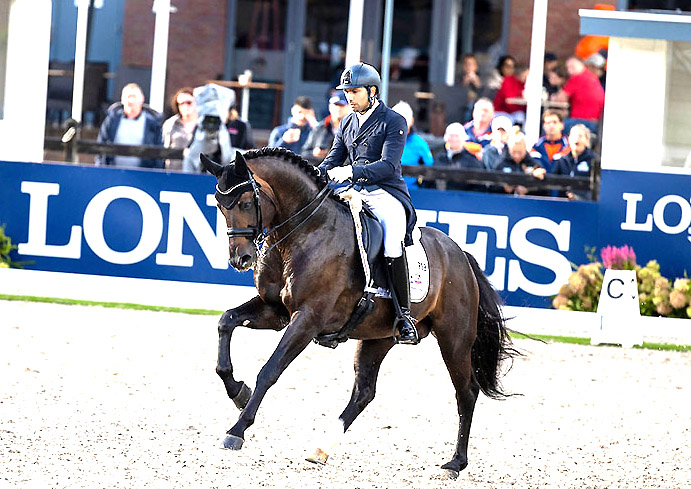Words Christopher Hector, pictures Roz Neave, Rebecca Ashton and archives
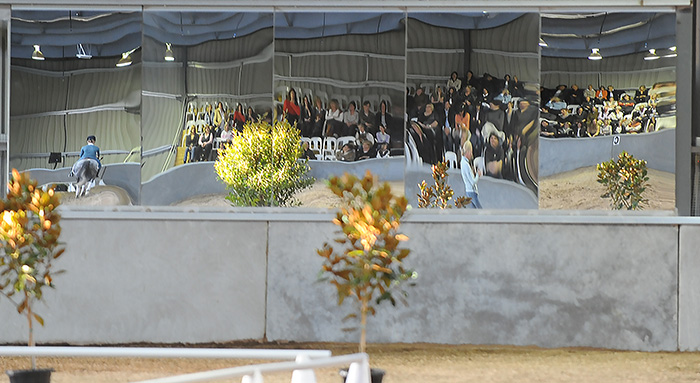
She may well be Princess Nathalie zu Sayn-Wittgenstein-Berleburg, but she is also refreshingly down-to-earth and totally without pretension. On one of her early tours to Australia, it was my job to MC the master class, and she assured me then that calling her Nathalie was just fine by her. Since then Nathalie has become a regular visitor to Australia and one of those people that it is always a buzz to meet at the big international competitions. Over the intervening ten years, Nathalie’s rôle has evolved, from a top ten international competitor, to mentor and team manager to a Danish team that looks a serious medal contender at the next Olympics – where-ever, and when-ever they may be held.
So let’s roll the clock back a decade and sit in on one of her first Master Classes in the Antipodes…
The teaching tours to Australia were arranged by another Dane, Victorian resident, dressage rider, and the brains behind the Catago Fashion Riding wear, Pernille Hogg, and there was more than a touch of Pernille’s flair and style when we arrived and were greeted on the evening of the Master Class with a glass of champers…
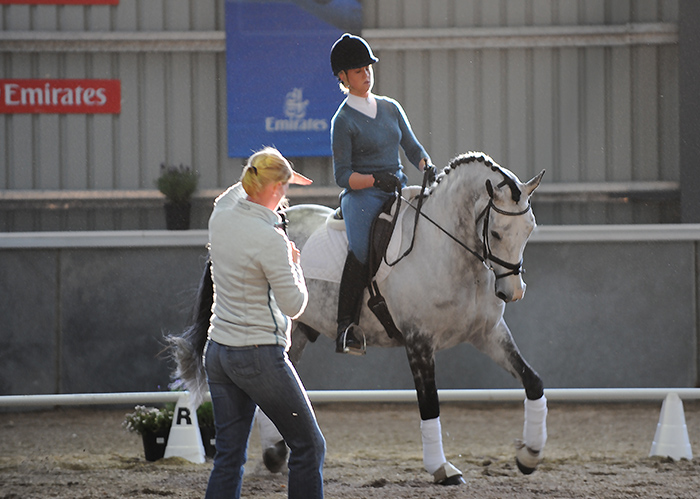
The gallery was packed as I introduced our guest, with a brief history of her equestrian involvement…
Nathalie was just ten years old when her mother, Princess Benedikte, took her to the European Dressage Championships in 1985 and Nathalie decided there and then to be a dressage rider. Nine years later in 1994, she went to Sweden to train with Kyra Kyrklund at Flyinge and stayed four years.
In 1996 she was a member of the Bronze Medal winning Danish Young Rider team.
In 1998 Nathalie continued her education with Klaus Balkenhol, and under his guidance, was the reserve for the Danish team at the Sydney Olympics. In 2001 she won a teams bronze medal at the European Championships. The following year she became the Danish Champion and was a member of the 4th placed Danish team at the WEG in The Hague. In 2004 she was once again an Olympic reserve, this time Athens. In 2006, she was a member of the 4th placed Danish team at the WEG in Jerez.
Nathalie won her third Danish championship in 2007 and was once again a member of the Danish team for the Europeans – this time she would have been 9th in the freestyle – except her horse jumped out of the arena and disqualified her!
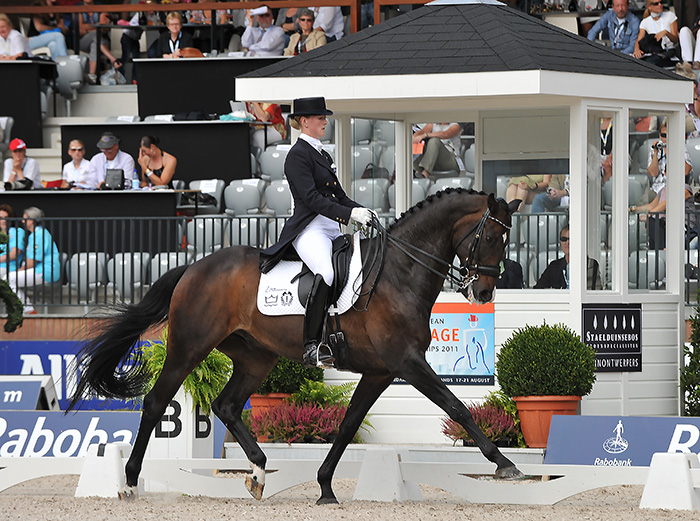
In 2008 came her first Olympic medal, in the bronze medal winning team at the Hong Kong Games… it was also the first year Nathalie came to Australia to give clinics.
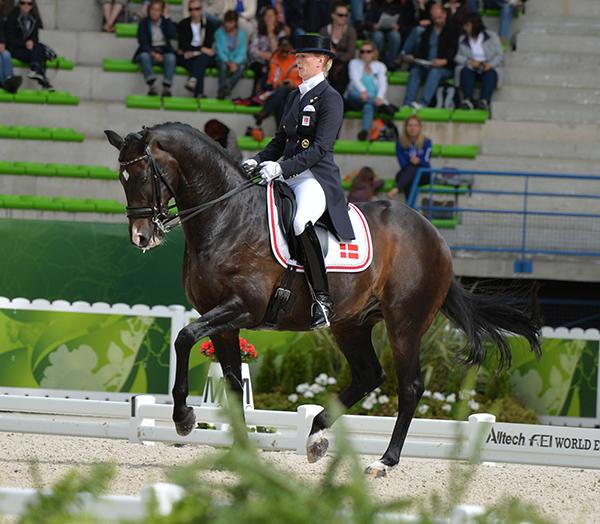
Nathalie and Digby at the 2014 WEG in Normandy
After her time with Klaus, Nathalie is now back training with Kyra – or, to be more exact, with Kyra’s husband, Richard, but as she tells the packed crowd at Oakwood, she is trying to find her own way:
“I’ve tried to pick the best from two great trainers and find my own handwriting. I am not Kyra or Klaus, I’m not that person, I have to find what works for me…”
Nathalie has been working with the Master Class participants in the days before, and reminds Bianca Barnes that when she rode her grey gelding, Belcam Cadell (by Capone) the day before, she felt he was a little dead to her leg…
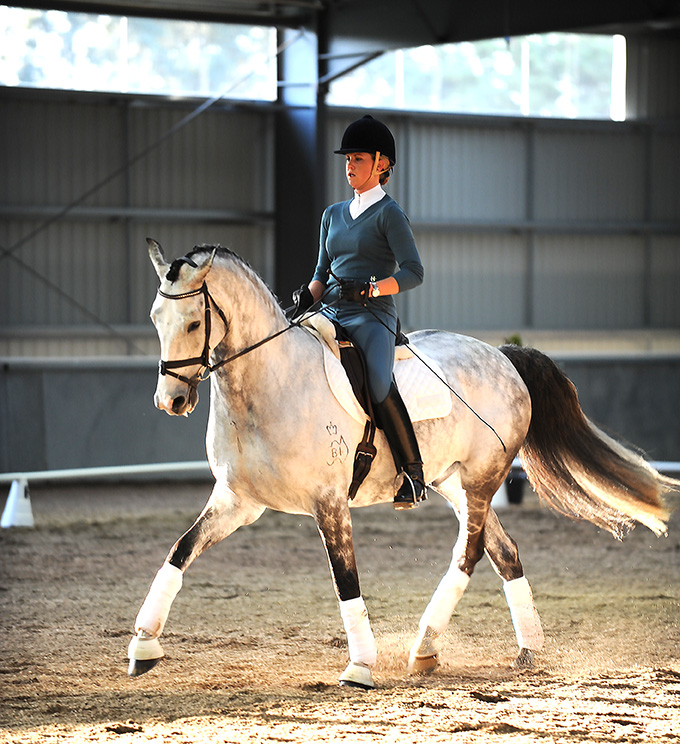
“When I put the leg on yesterday, nothing happened. He doesn’t push off from the hind leg. Use the whip, I want him to learn to come with the leg and get his hind end under. Go forward, half halt, then let go, let him learn to carry his own weight, then the rider can just sit there like nothing is happening.”
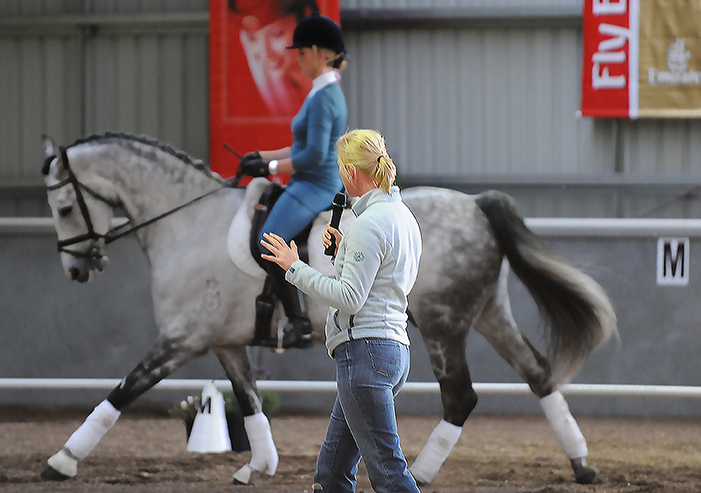
“Half halt, don’t let go until he slows into the tempo you want. The half halt is not just to get the horse on the hind leg and in self carriage, it is also about control. Is the horse listening to me? Yes, the young horses have to learn to go forward but they also have to listen and come back. You don’t just put them into gear and forget about it, you have to work on it all through their lives.”
“What you are aiming at is a really light connection – just grams – really soft contact. If they don’t react to a soft aid to go forward, come with the whip, but the next time, you have to be just as soft. If you want the horse to react quick, you have to think quick. Klaus was always saying, think quick, think quick… then you find that you haven’t actually done anything but it happens!”
“With the contact, you should have the feeling of knitting, the bit should be moving a little in his mouth. The horse must start reaching for the rein, and that’s a feeling you have to keep.”
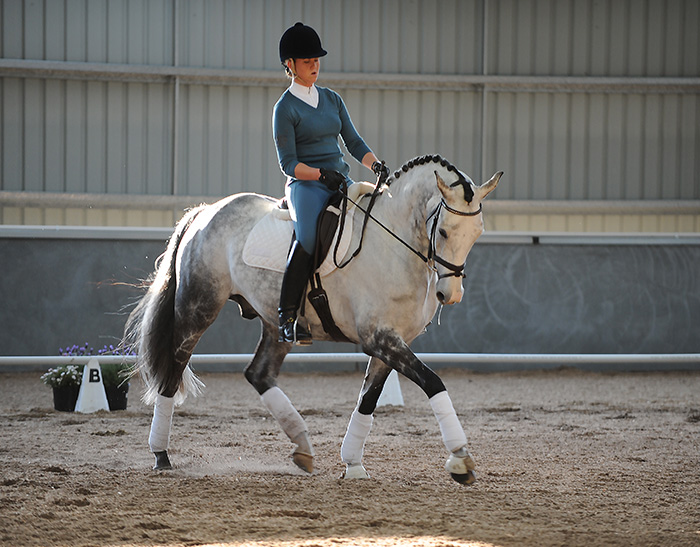
“Get the feeling that you can really control where the shoulders go, you want to sit on the engine, the hindquarters, and manoeuvre the front end around. Control yourself, so you can give once in a while – when you can do that, you’ve come a long way. Half halt in shoulder in, half halt in shoulder in, half halt in shoulder in: half halts are 80% of dressage. How good the half halts are, that’s how good your dressage test will be. Remember to ride a half halt through the corner to prepare for the next movement.”
It was time for a little sideways – Leg yield on the centre line – but again, Nathalie was looking for control:
“When you leg yield, be able to make it fast, to make it short, to make it fast, to make it short – play with it. Then you really get control of the rhythm, he doesn’t think ‘if I go sideways I can do it in MY rhythm.”
“He is a little slower on one leg than the other. You have to work to get the left side as good as the right side – probably the not-so-good side is never going to be as good as the natural side, but it can get better.”
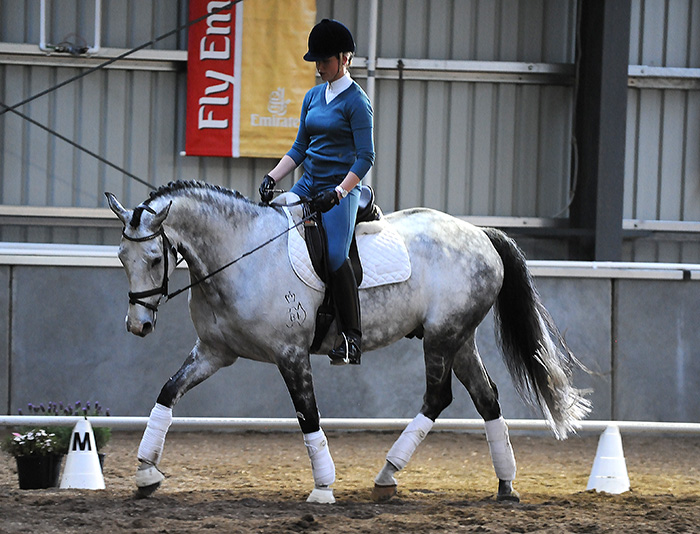
It was time for a break, time for the horse to walk: “That’s something I really learnt from Klaus, really go into walk – give a longer rein, let the horse relax. When the horse is holding itself, the blood can’t go through the muscle and it gets harder for the horse, and then the rider tries harder and harder, and the horse goes worse and worse. It is so important for the blood to flow through the muscles – walk in between the exercises and get the muscles loose again.”
“For this horse it is not difficult for him to do the movements, what is difficult for him as a five-yearold, is to stay in self carriage, and for that he has to be supple through his whole body.”
“If the movement is getting worse, go back, just get the horse moving, get him over the back again. This might be for a few weeks, a few days, even one day, but when you get a problem, go back to the real ground work.”
Time to try some canter work: “Get the feeling that you are riding him off your seat and you could let go with your hands. If you feel he is getting slow, a little touch, touch, then sit quiet. It should be less and less work for the rider. You feed the horse every day and ride him for just one hour – for that hour, your horse can work for you. Try to collect the canter as much as you can without using your hand…”
Right at this point, Cadell is losing revs, and Nathalie wants action: “There you should have realized he was losing it and needed a bit more forward – FORWARD FORWARD FORWARD! He’s not reacting to your leg. You have to be really clear what you want – the horse is a mirror for the riding, what do you want?”
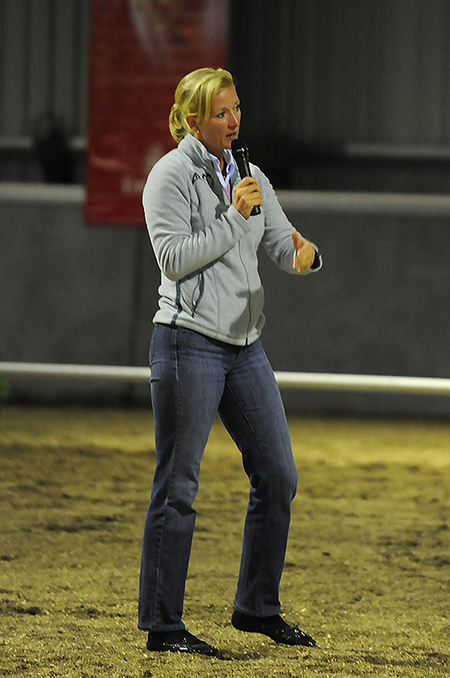
“I’ve been working on my own since 2005, and I find I have to be so disciplined. Was I pleased with that? If not, you have to do it again, and again, and again, until you are pleased. Put if off until tomorrow, then next week, then you are never going to get it.”
Still Nathalie is pleased with her pupil and her horse. “This horse has really weird breeding, it’s wild, Warmblood, Arab and Lippizaner. In Germany they would tell you it is impossible, but it is possible. When you are training him at home, be careful to vary your training. Some days just go for a ride in the forest, some days only baby ground work, some days, ride only the movements, keep it varied because only a motivated and happy horse will start working for you. Even with my Grand Prix horses, I start long in a really natural trot, and after the training, it’s the same.
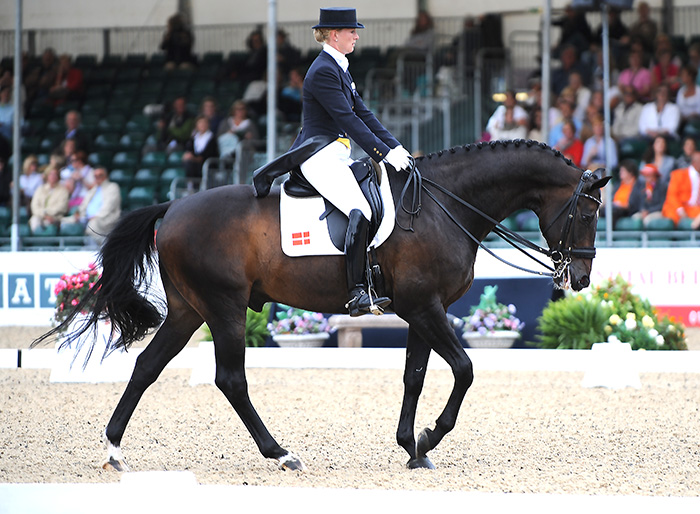
When a horse can do that, go long and natural after 45 minutes of training, then you know you have been on the right way. If you give him the rein after 45 minutes and he takes off, then you have done something very wrong. It’s important in a country like Australia where you don’t have a trainer all the time, to video your lessons, and go back and look at them every now and then and ask ‘am I going off the road?’ I’ve been lucky to have had two fabulous trainers, but it also comes with age – and perhaps wisdom. You know when you are on the right way…”
Nathalie also worked with Maree Tomkinson and her imported mare, Diamentina. Nathalie’s introduction is typical of her dry sense of humour…
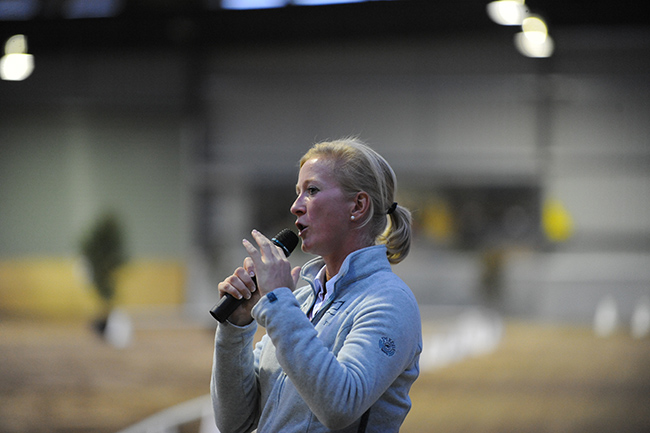
“You warm her up a bit Maree while I babble a bit. This mare is an eye catcher, but eye catchers really require disciplined riding. With a horse with big movement and lots of talent, you can see when it starts to go wrong. A horse likes this needs lots and lots of self-discipline. Maree is really disciplined, that’s what she learnt in Germany: discipline, discipline, discipline. You have to be really tough on yourself.”
“You can see in just the warmup, this mare is so active behind, so uphill, it’s lovely to see. It must be wonderful to ride a horse like that – my two, when they were young, no-one would say ‘this horse will go Grand Prix’. As Georg Theodorescu said, ‘horses are not born Grand Prix horses, riders make a Grand Prix horse.’
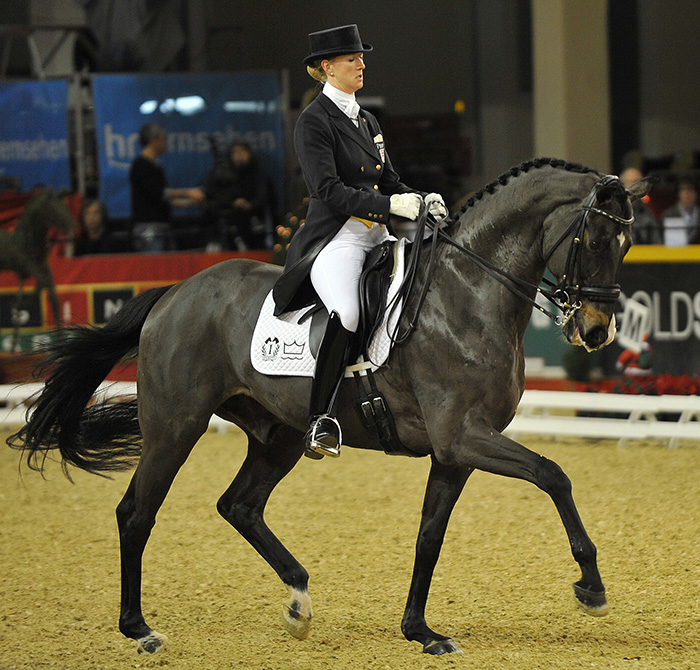
The horse can have an average motor, but if it has got the head, you can make it something. Kyra’s Max, and my Digby, are not the biggest movers, but with a lot of work, they made nice dressage horses.”
Turning to Diamentina and Ree, Nathalie explained what they had been working on: “Yesterday, we tried to get her loose at the bottom of the neck. This is a horse with a good neck but it can get tight – she needs to loosen her neck and get her back up to make the back stronger. That’s something you will have to work on all her life. The judges can write ‘high in the neck’ but you can work on it. My horse Rigoletto always got the note ‘too short’ but he was not strong enough to stay with his neck out, with his nose out. Now he is 13, he can do it.”
Once again, Nathalie, wants to keep the warm-up simple: “Just a joggy trot, let go and just ride forward. This mare is like Totilas, with a really big trot, and that makes it hard to slow her down.
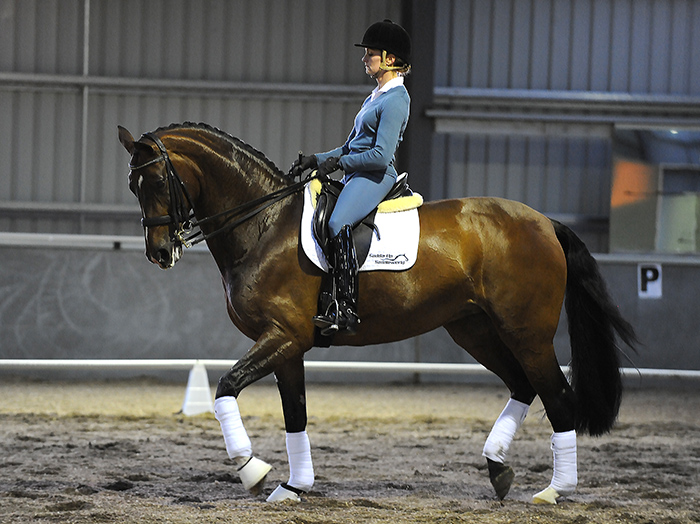
You have to prepare in the corner to shorten the trot down. Bring her back to a joggy trot, give her the rein, and see if she will stay there. If you don’t have enough activity in that joggy trot, a little touch with the whip, and feel the hind legs stepping up. Feel the swinging through her body, sometimes horses get worried in that joggy trot, when you pat them, they realize that they can really relax…”
“If you are aware as a rider that you have held on too long and know it’s time to give – that’s when you have understood give and take, it’s a weird but fantastic feeling to understand that.”
It was time to try some work in canter:
“Canter her back and forward, get her to react quicker to you. Bring her back so she collects by herself without your helping her.”
Now try some half passes. First in normal canter, then after a few strides, collect a little, but still going to the side. At the beginning we are just teaching the horse to go to the side, but eventually you want to be able to control the tempo.”
It was on to the flying changes:
“She tends to come back to the rider in the change to the left. I’d try to make her a little deeper into the change. When you start working young horses they are really rideable and soft into the hand, but when you start to collect they get a little stronger and less supple – but it is important to get back to the feeling you had. If the horse just gets stronger and stronger, you should go back to baby work.”
“Maree was lucky, she had a real school master in Lanzaro, you don’t learn from an easy horse. My first Grand Prix horse – he’s 19 now – was not easy, I had to carry him around but I learnt everything, and after that, the next horses were easy.”
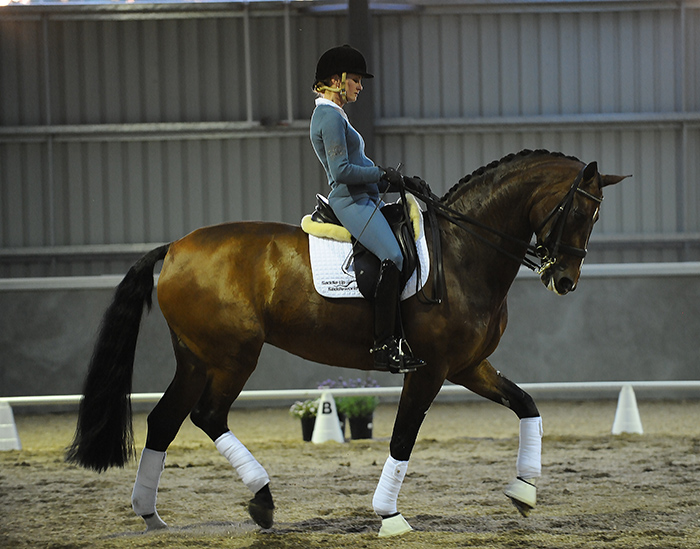
It was time to show a few shortened steps:
“When they are six or seven you start to teach piaffe and passage. For some it is easier to start with piaffe, others passage, listen to the horse. Just one or two steps of passage Maree, then stepping out. When the horse feels really supple in the back, then ask for just a step. That was really good, now rising trot, long and low. We can all agree this is a fantastic horse…”
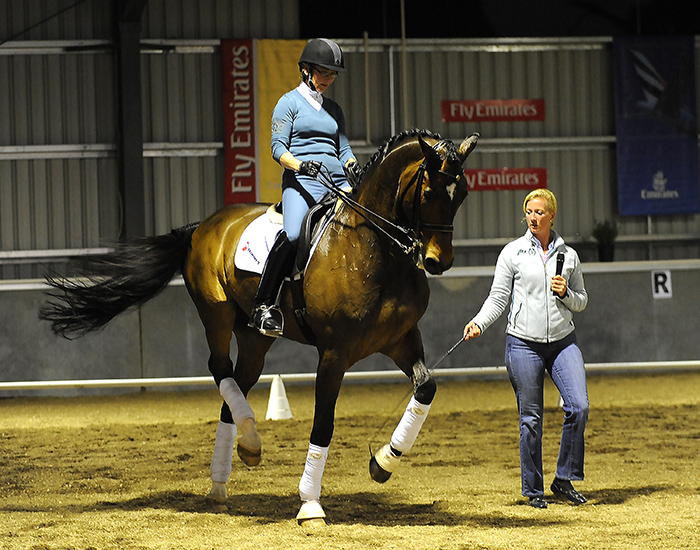
“We’ve seen two completely different horses. The first was a lovely young Australian bred horse. Conformation wise, it is a little low over the ground, but when he moves, you forget that, and he looks long legged. The second is the prototype of the modern sporthorse, and now we have our third horse, Come To Me with Charlotte Pedersen. This is a Danish horse but with a Holsteiner topline and with May Sherif on the mare line. He has quite long legs and quite a lot of body, and Charlotte is not the tallest rider – she has to keep this horse, so it is easy for her to ride. The horse has a big, big trot and then it is difficult to manouevre him through the corners. We are working on getting him more manouevrable and getting his legs under him.”
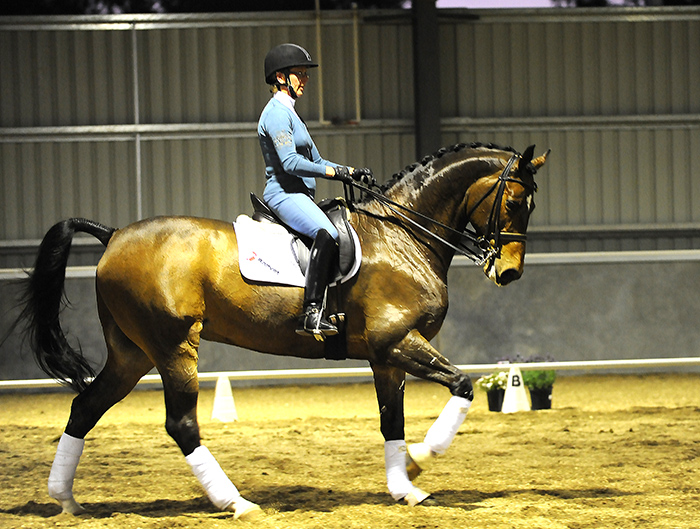
“Sit back and look up Charlotte. Make him straight, make him adjustable. The horse is a little long in the hind legs and the hind legs are a little out behind. We are trying to get him comfortable in the trot so Charlotte doesn’t have to do so much, and the tail doesn’t swish so much. Be careful, if you take your lower leg back, it pushes your upper body forward. If you keep the leg on the girth, you can really sit.”
“Shoulder-in helps, the horse has to use the inside hindleg. When he gets out behind, the hind-legs get slow because they have to come such a long way. You have to feel that the hind-legs don’t swing out, but come straight under the horse.”
“All three horses need to be quicker off the rider’s leg. They need to go back and forward, they need to shorten the body quicker, to lengthen their body quicker, they need to listen to the rider…”
This article was first published in the November 2009 edition of The Horse Magazine
POSTSCRIPT: Nathalie and her Danish Team
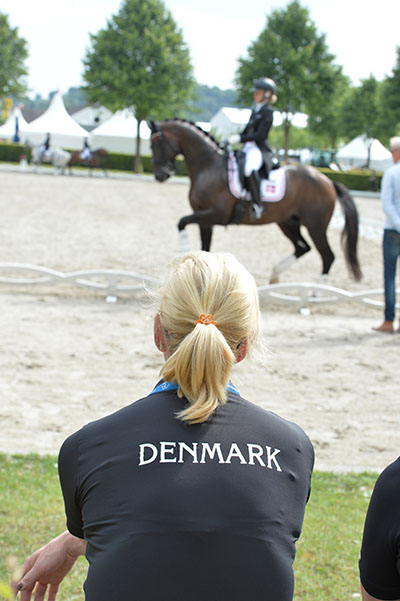
Three years ago, Nathalie was the new face in the lineup of National Dressage Coaches at Aachen, and since then she has well and truly established her team as a force to be reckoned with…
The team made their presence felt with a fourth placing in the Nations Cup at Aachen. At the European Championships they went even better and finished with a Silver team medal, and team star, with Cathrine Dufour and Cassidy winning two individual Bronze Medals behind German stars Isabell Werth and Sönke Rothenberger.
Princess Nathalie has lost no time in her new rôle as coach of the Danish dressage team and there was a new buzz around her squad at Aachen…
Looking at you working with your team, there’s a whole new feeling about Danish dressage…
“Thank you…”
And it was nice to watch their warmups, they all worked very quietly, very correctly, very sympathetically…
“I am trying to give them security, that you can ride them in that way, and that’s the only way that really works. You have to have them through from the beginning.”
You seem to have some new combinations…
“They have all been thereabouts in some way. Agnete Kirk has had Jojo for quite some time, and it is just a matter of giving her a new way of thinking to get a little more out of him.
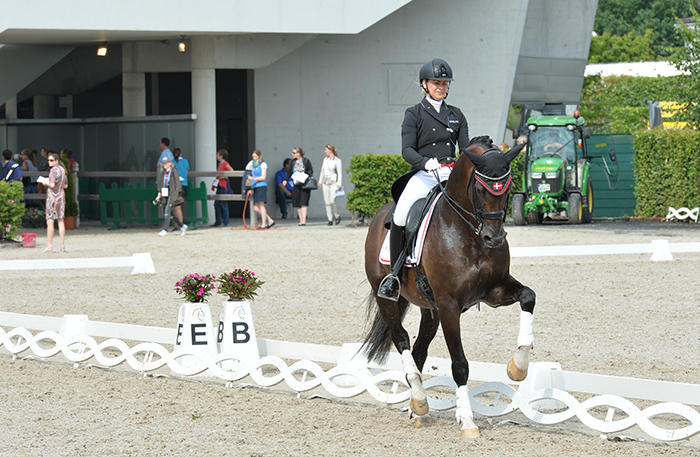
Agnete Kirk Thinggaard and Jojo
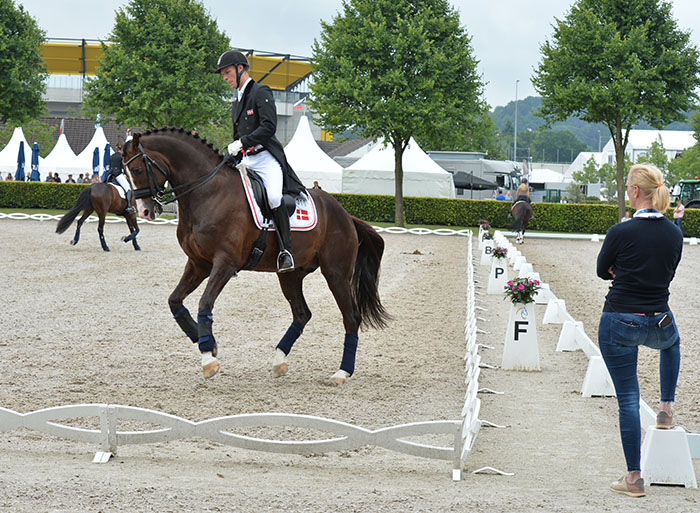
Daniel Bachmann Andersen and Blue Hors Don Olymbrio
“Daniel was reserve for Rio last year with Hotline, but with Don Olymbrio, and Zack, he has made them more or less, so it’s more his horses – especially Don Olymbrio that he has here, the little cutey – we call him the pony – he has ridden the horse since he was seven or eight. He has made him and you can see that. It’s his hand-writing, and the horse suits him. They know each other…”
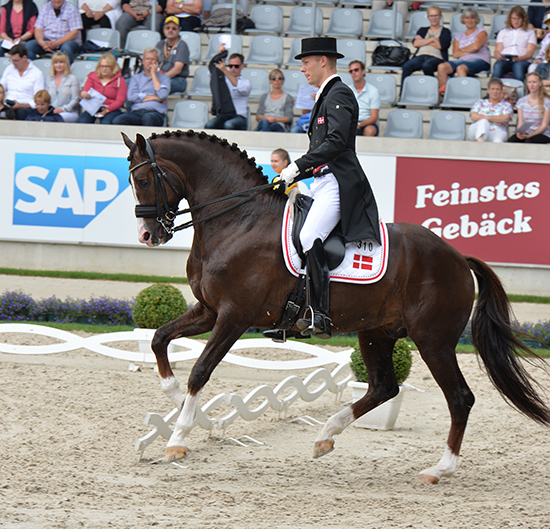
Daniel may not be riding Olymbrio any more but he is starring on the number one ranked stallion – Blue Hors Zack…
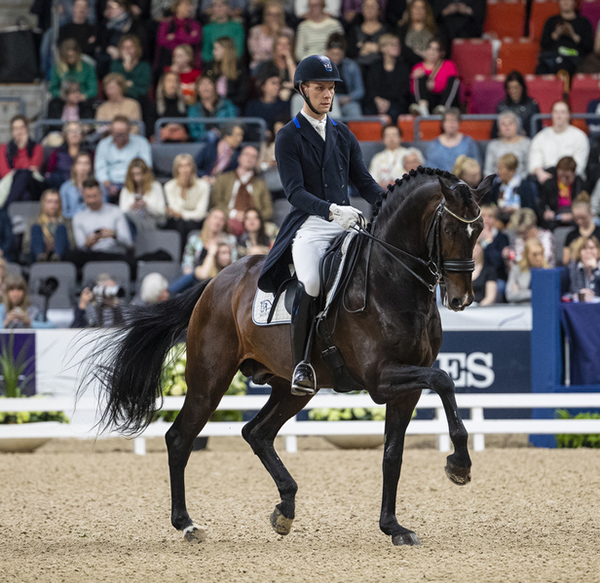
Back then it looked like the Danish trump card would be Cathrine Dufour and Atterupgaards Cassidy.
“Cathrine is mentally so bloody strong, she knows exactly what she wants, she is just out of the under 25 class, but she is mentally so strong. The horse and she, they know each other in-and-out, so she knows exactly when she has to press each button, and when she has to stand back a bit and let him go. It’s a combination to watch.”
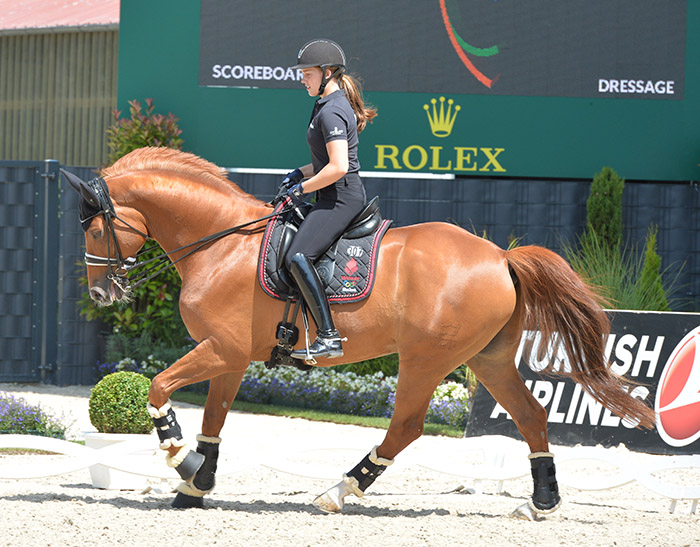
The secret weapon – Cassidy – working on the day before the Grand Prix and finishing in fourth place behind Isabell Werth, Laura Graves, and Sönke Rothenberger!
And just when you thought it couldn’t get any better – Cathrine produces a new star, and declares that he is now her first choice for the Danish Team – Bohemian.
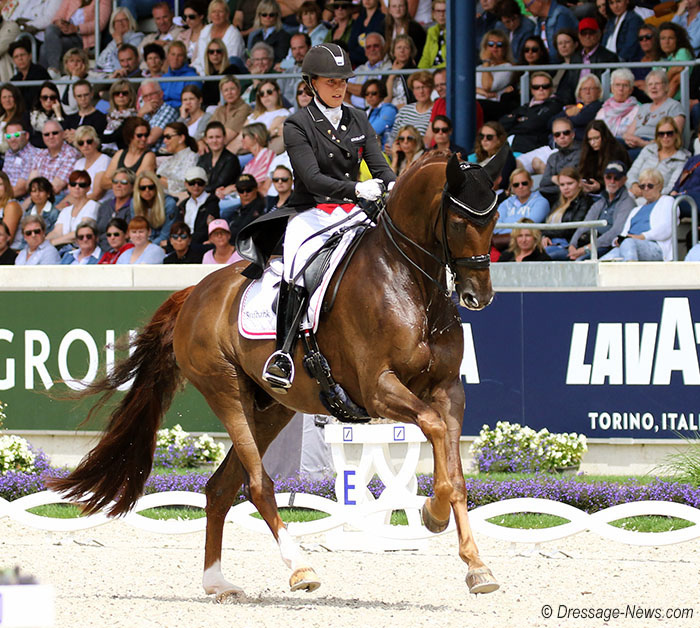
Things are looking good for Nathalie and her team, all we need now is for the Corona virus to go away, and the Games to begin…
Looking at dressage stallions? Australian breeders will find the right stallion for their mare at International Horse breeders – www.ihb.com.au
Stallion stars like Foundation
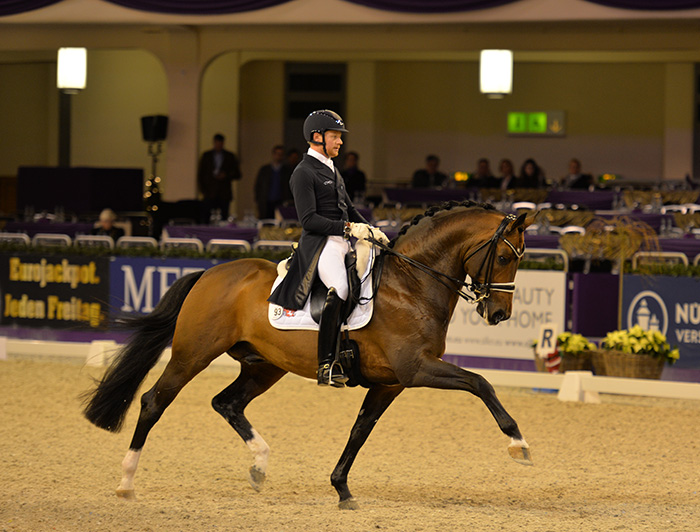
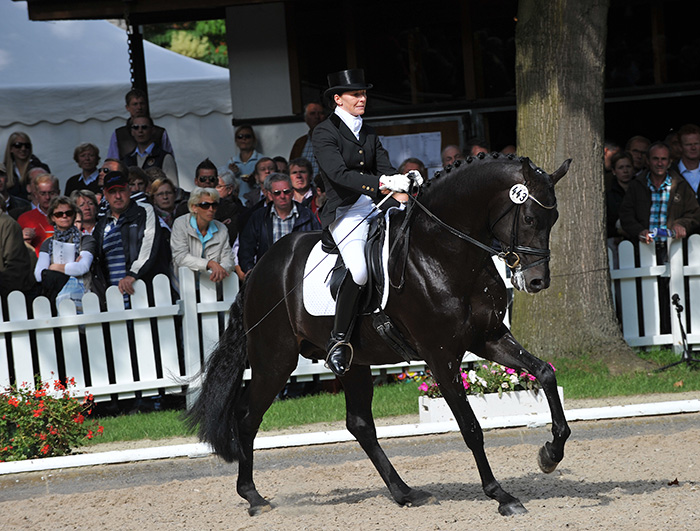
Or Fürstenball, and many, many more, including the latest young stars like…
